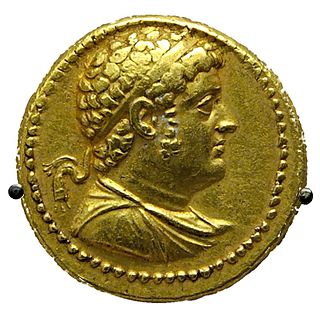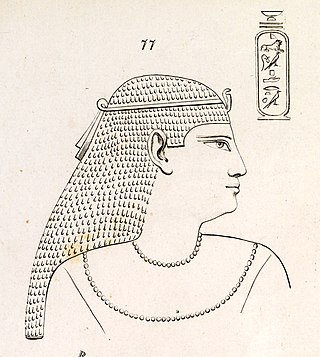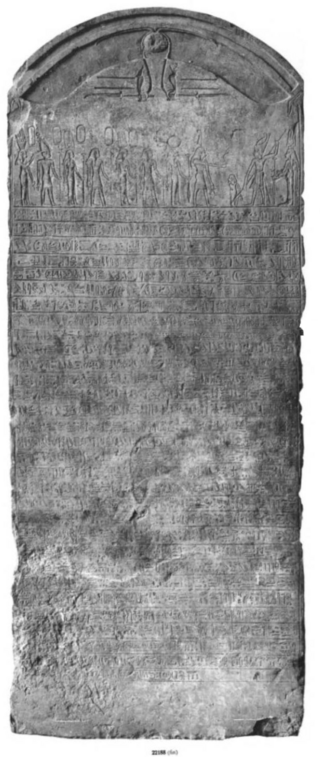Related Research Articles

The Rosetta Stone is a stele of granodiorite inscribed with three versions of a decree issued in 196 BC during the Ptolemaic dynasty of Egypt, on behalf of King Ptolemy V Epiphanes. The top and middle texts are in Ancient Egyptian using hieroglyphic and Demotic scripts, respectively, while the bottom is in Ancient Greek. The decree has only minor differences across the three versions, making the Rosetta Stone key to deciphering the Egyptian scripts.

Ptolemy III Euergetes was the third pharaoh of the Ptolemaic dynasty in Egypt from 246 to 222 BC. The Ptolemaic Kingdom reached the height of its military and economic power during his kingship, as initiated by his father Ptolemy II Philadelphus.

Ptolemy IV Philopator was the fourth pharaoh of Ptolemaic Egypt from 221 to 204 BC.

Ptolemy V Epiphanes Eucharistus was the King of Ptolemaic Egypt from July or August 204 BC until his death in 180 BC.

Cleopatra I Syra was a princess of the Seleucid Empire, Queen of Ptolemaic Egypt by marriage to Ptolemy V of Egypt, and regent of Egypt during the minority of their son, Ptolemy VI, from her husband's death in 180 BC until her own death in 176 BC.

The Battle of Raphia, also known as the Battle of Gaza, was fought on 22 June 217 BC near modern Rafah between the forces of Ptolemy IV Philopator, king and pharaoh of Ptolemaic Egypt and Antiochus III the Great of the Seleucid Empire during the Syrian Wars. It was one of the largest battles of the Hellenistic kingdoms and of the ancient world, and determined the sovereignty of Coele Syria.

Deshret was the Red Crown of Lower Egypt. When combined with the Hedjet of Upper Egypt, it forms the Pschent, in ancient Egyptian called the sekhemti.

The Decree of Canopus is a trilingual inscription in three scripts, which dates from the Ptolemaic period of ancient Egypt. It was written in three writing systems: Egyptian hieroglyphs, demotic, and Koine Greek, on several ancient Egyptian memorial stones, or steles. The inscription is a record of a great assembly of priests held at Canopus, Egypt, on 7 Appellaios (Mac.) = 17 Tybi (Eg.) year 9 of Ptolemy III = Thursday 7 March 238 BC. Their decree honoured Pharaoh Ptolemy III Euergetes; Queen Berenice, his wife; and Princess Berenice.

The Ptolemaic Kingdom or Ptolemaic Empire was an Ancient Greek polity based in Egypt during the Hellenistic period. It was founded in 305 BC by the Macedonian general Ptolemy I Soter, a companion of Alexander the Great, and ruled by the Ptolemaic dynasty until the death of Cleopatra VII in 30 BC. Reigning for nearly three centuries, the Ptolemies were the longest and final dynasty of ancient Egypt, heralding a distinctly new era for religious and cultural syncretism between Greek and Egyptian culture.
The Ptolemaic Decrees were a series of decrees by synods of ancient Egyptian priests. They were issued in the Ptolemaic Kingdom, which controlled Egypt from 305 BC to 30 BC. In each decree, the benefactions of the reigning pharaoh, especially towards the priesthood, are recognised, and religious honours are decreed for him.

The ancient Egyptian Mast hieroglyph is one of the oldest language hieroglyphs from Ancient Egypt. It is used on a famous label of Pharaoh Den of the First dynasty, but forms part of the location hieroglyph: Emblem of the East.
The ancient Egyptian horizontally-outstretchedArm with powerstick is a hieroglyph with the meaning of "force", or "power of action". As a baton, or macehead. Power is obvious, but the origins may have also had references to magic, or the idea of driving-off evil spirits or omens.

The ancient Egyptian Man-prisoner is one of the oldest hieroglyphs from Ancient Egypt. An iconographic portrayal from predynastic Egypt eventually led to its incorporation into the writing system of the Egyptian language. Not only rebels from towns or districts, but foreigners from battle were being portrayed.
In ancient Egyptian hieroglyphs, the hand symbol represented the phoneme /d/, and was also used as a determinative for actions performed as if with the hands.
The ancient Egyptian Dua hieroglyph is one of a series of language and visual hieroglyphs used from the earliest dynasties of Ancient Egypt, and that portrays men, women, ideology, and some occupations.
The ancient Egyptian Papyrus stem hieroglyph is one of the oldest language hieroglyphs from Ancient Egypt. The papyrus stalk, was incorporated into designs of columns on buildings, also facades, and is also in the iconographic art portrayed in ancient Egyptian decorated scenes.
The ancient Egyptian Branch hieroglyph, also called a Stick, is a member of the trees and plants hieroglyphs.

The Rosetta Stone decree, or the Decree of Memphis, is a Ptolemaic decree most notable for its bilingual and tri-scriptual nature, which enabled the decipherment of Egyptian hieroglyphs. Issued by a council of priests confirming the royal cult of Ptolemy V in 196 BC at Memphis, it was written in Egyptian hieroglyphs, Egyptian Demotic and Ancient Greek. It mentions the Egyptian rebellion against the Greek rulers, otherwise known only through Greek sources and remains of graffiti.

The Nubayrah Stele is a mutilated copy of the Decree of Memphis on a limestone stele. The same decree is found upon the Rosetta Stone. From 1848, it was known that a partial copy of the Decree was on a wall at the Temple of Philae, but overwritten in many places, by scenes, or damaged.

The ancient Egyptian Arms-in-embrace hieroglyph, Gardiner sign listed no. D32 is a portrayal of the embracing human arms. The hieroglyph is in the large Gardiner sign list category of Parts of the Human Body.
References
- Budge. The Rosetta Stone, Sir E.A.Wallis Budge, (Dover Publications), c 1929, Dover edition (unabridged), c. 1989. (softcover, ISBN 0-486-26163-8)